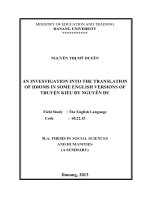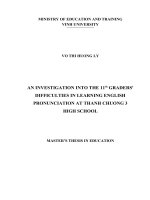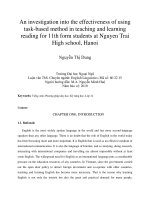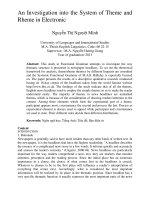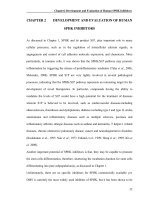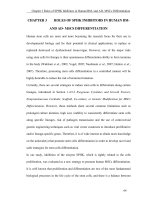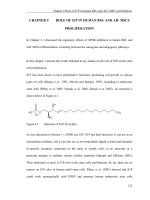an investigation into the role of chemokines in haemopoietic stem cell quiescence
Bạn đang xem bản rút gọn của tài liệu. Xem và tải ngay bản đầy đủ của tài liệu tại đây (7.6 MB, 309 trang )
Glasgow Theses Service
Sinclair, Amy (2015) An investigation into the role of chemokines in
haemopoietic stem cell quiescence. PhD thesis.
Copyright and moral rights for this thesis are retained by the author
A copy can be downloaded for personal non-commercial research or
study, without prior permission or charge
This thesis cannot be reproduced or quoted extensively from without first
obtaining permission in writing from the Author
The content must not be changed in any way or sold commercially in any
format or medium without the formal permission of the Author
When referring to this work, full bibliographic details including the
author, title, awarding institution and date of the thesis must be given
1
AN INVESTIGATION INTO THE ROLE
OF CHEMOKINES IN HAEMOPOIETIC
STEM CELL QUIESCENCE
Amy Sinclair
BSc (hons), MRes
Submitted in fulfilment of the requirements for the degree of Doctor of
Philosophy
August 2013
Section of Experimental Haematology
Institute of Cancer Sciences
College of Medical, Veterinary and Life Sciences
University of Glasgow
2
Abstract
Haemopoietic stem cells (HSC) maintain lifelong haemopoiesis through the monitoring
and production of cells from multiple haemopoietic cell lineages. A key property of HSC is
their ability to maintain quiescence. Quiescence refers to a state of inactivity in which the
cell is not dividing and remains dormant. It is this property of the HSC that is thought to
maintain genomic integrity and to allow the HSC to sustain haemopoiesis over the period
of a lifetime. However, the regulation of quiescence in this context is not well understood.
Numerous studies have aimed to understand the molecular mechanisms underlying HSC
quiescence using high-throughput approaches. A previous microarray study by our group
aimed to understand the transcriptional differences between quiescent and proliferating
human HSC. Data from this microarray showed that the most up regulated group of genes
in quiescent compared to proliferating human HSC were chemokine ligands, specifically
within the CXC family. Although this was a novel finding at the time, the biological
function of these chemokine genes was not studied until the current work presented here.
In this thesis, we aimed to extend foregoing research and importantly, investigate the role
of CXC chemokines in HSC properties, using both human and mouse systems.
First, we validated the results from the microarray study using gene expression analyses to
show that chemokine ligands CXCL1 and CXCL2 were significantly up regulated in
quiescent HSC (CD34
+
CD38
-
) in comparison to more proliferative progenitors
(CD34
+
CD38
+
). Focusing on CXCL1, we showed positive expression of the ligand protein
in human stem/progenitor cells using immunofluorescence and western blotting on human
primary CD34
+
cells. In addition, we identified positive expression of receptor CXCR2 by
gene and protein analyses on CD34
+
cells, indicating the presence of an autocrine
chemokine signalling loop. To determine the biological function of CXCL1/CXCR2
signalling in human HSC, we used shRNA to reduce CXCL1 expression and a
commercially available inhibitor (SB-225002) to block CXCR2 receptor signalling.
Experiments on cell lines expressing CXCL1 and CXCR2 (HT 1080) showed that
reduction of CXCL1 and over-expression reduced or increased cell viability and
proliferation respectively. Experiments on human primary CD34
+
cells revealed that
reduction of CXCL1 induced apoptosis and reduced colony formation. Similarly, inhibition
of CXCR2 signalling in CD34
+
cells using SB-225002 induced apoptosis and reduced
colony formation in a dose dependent manner. However, due to human sample availability
and technical challenges, experiments need repeated in order for a valid conclusion to be
3
made and statistical analysis could not be carried out for some primary experiments. In
addition, further experimental work is required to conclusively prove that human
stem/progenitors express CXCL1 and CXCR2 as different techniques showed varying
results. In summary, we provide some evidence that CXCL1 and CXCR2 is expressed by
human HSC and may be an important survival pathway in normal human HSC which
requires further experimental data to provide valid conclusions.
In order to gain a deeper understanding of the biological function of chemokine signalling
in HSC biology, we used an in vivo murine system. First, we examined mRNA transcripts
of CXC chemokines in mouse HSC populations. We screened a small selected group of
CXC chemokines using primitive mouse HSC and single cell quantitative PCR using the
Fluidigm™ platform. Gene expression analyses identified that Cxcr2 and Cxcl4 mRNA
transcripts were detected including in the most rare, primitive HSC fraction. To elucidate
the mechanism of action, we used a transgenic reporter and knock out mouse models for
both genes of interest. Analysis of a Cxcr2 null mice model (Cxcr2
-/-
) validated previous
research in which animals lacking Cxcr2 show disrupted haemopoiesis with an expansion
of myeloid cells in the haemopoietic organs. Interestingly, within the current work,
analysis of steady state haemopoiesis revealed an expansion of the most primitive HSC in
the BM of animals lacking Cxcr2 and enhanced mobilisation demonstrated by an increase
in the stem/progenitor activity in the spleen and PB. HSC functional analyses using BM
reconstitution assays with wildtype (WT) or Cxcr2
-/-
HSC showed that there was a trend
towards a reduction in engraftment in animals transplanted with HSC lacking Cxcr2.
However, this result was not statistically significant due to high sample variability and due
to time constraints and the length of this assay, this was not repeated. The data suggests
that Cxcr2 expressing HSC may be important for stem cell maintenance via a cell
autonomous mechanism however experiments are required to be repeated to draw valid
conclusions.
Cxcl4-Cre transgenic mice containing a RFP construct under the control of the Rosa26
promoter (Cxcl4-Cre) showed RFP expression in HSC and progeny. RFP expression in
HSC populations was in accordance with Cxcl4 mRNA transcripts therefore suggesting
RFP expression was correlated with endogenous Cxcl4 expression. Interestingly, flow
cytometry analysis identified that not all (~50%) HSC showed positive expression for RFP.
Flow cytometry sorting of positive and negative populations revealed that cells with
enhanced colony formation potential reside within the RFP (Cxcl4) positive fraction. To
extend this data, we aimed to knock out and reduce Cxcl4 expression and examine the
4
phenotype. Targeted deletion of Cxcl4 in vitro using a Cxcl4 shRNA vector demonstrated
that Cxcl4 reduction in vitro diminished colony formation in primary and secondary
replating assays. Since data for human CXCL4 mRNA were not conclusive from the
original microarray, we reassessed the relevance of CXCL4 in the human system. Gene
expression analyses showed that CXCL4 transcripts were indeed detected and furthermore,
up regulated in primitive HSC (CD34
+
CD38
-
CD90
+
) compared with proliferative
progenitors (CD34
+
CD38
+
). Collectively, the data indicates that CXCL4 may play an
important role in mouse and human HSC biology, however further experimental work is
required to address this.
In summary, the data presented in this thesis demonstrate that several chemokines
including CXCL1, CXCL4 and receptor CXCR2 may have key roles in HSC survival and
maintenance, both in the mouse and human systems. However, increased biological
replicates and further experiments are required to draw valid conclusions. Enhanced
understanding of the regulation of stem cell properties is critical for improving our ability
to manipulate normal stem cells in vitro and in vivo. Furthermore, understanding normal
stem cell regulation is fundamental for the research of diseases such as leukaemia in which
leukaemic stem cells are less sensitive to drug treatment.
5
Table of Contents
Abstract 2
Table of Contents 5
List of Tables 8
List of Figures 9
Related Publications 13
Publications in Preparation 14
Acknowledgements 15
Author’s declaration 16
List of Abbreviations 17
1
Introduction 22
1.1
The history of stem cells 22
1.2
Regenerative medicine 23
1.3
Haemopoiesis 24
1.3.1
Self renewal and differentiation 24
1.3.2
The haemopoietic hierarchy 30
1.3.3
HSC identification and isolation 33
1.3.4
HSC cellular fates 38
1.3.5
HSC kinetics 41
1.3.6
Intrinsic regulation of HSC behaviour 43
1.3.7
BM niche 44
1.3.8
Methods for understanding HSC cellular fate decisions 51
1.3.9
Study rationale 52
1.4
Chemokines 53
1.4.1
Classification 53
1.4.2
Signalling 56
1.4.3
Function 60
1.4.4
Chemokines in haemopoiesis 68
1.5
Thesis aims 73
2
Materials and Methods 75
2.1
Materials 75
2.1.1
Cell lines 75
2.1.2
Plasmids 75
2.1.3
Small molecule inhibitors 76
2.1.4
Tissue culture supplies 76
2.1.5
Molecular biology supplies 78
2.1.6
Flow cytometry supplies 79
2.1.7
Primers 81
2.1.8
Immunofluorescence supplies 82
2.2
Medium and Solutions 82
2.2.1
Tissue culture 82
2.2.2
Western blotting 84
2.2.3
Flow cytometry 85
2.2.4
Immunofluorescence 86
2.2.5
PCR 86
2.2.6
Cloning 87
2.2.7
Transfection 88
2.2.8
Microbiology 89
2.3
Methods 90
2.3.1
General tissue culture 90
6
2.3.2
Transfection 94
2.3.3
Stem cell selection 96
Flow cytometry and cell sorting 100
2.3.4
Immunofluorescence and immunohistochemistry 107
2.3.5
Western blotting 108
2.3.6
Molecular biology 110
2.3.7
Animal work 116
2.3.8
Statistics 122
3
Results I: The role of CXCL1/CXCR2 signalling in human HSC survival 123
3.1
Introduction 123
3.2
Aims and objectives 125
3.3
Results 126
3.3.1
CXCL1, CXCL2 and CXCL6 are up regulated in primitive, BM derived
HSC 126
3.3.2
CXCL1 is expressed in both CD34
+
CD38
-
and CD34
+
CD38
+
cells at the
protein level 130
3.3.3
CXCR2 is expressed by human CD34
+
CD38
-
and CD34
+
CD38
+
cells 135
3.3.4
Modulation of CXCL1 in HT 1080 cell lines alters cell viability and
proliferation 139
3.3.5
Reduction of CXCL1 in CD34
+
cells leads to a reduction in cell viability
and colony formation capability 147
3.3.6
CXCL1 over expression in CD34
+
cells does not alter colony formation . 152
3.3.7
Recombinant CXCL1 treatment of CD34
+
cells does not alter cell viability
or cell cycle status 154
3.3.8
CXCR2 inhibition on human CD34
+
cells using SB-225002 alters cell
viability, cell cycle status and colony formation 156
3.4
Discussion 162
4
Results II: Analysis of haemopoieisis and stem cell activity in Cxcr2
-/-
mice 165
4.1
Introduction 165
4.2
Aims and Objectives 166
4.3
Results 167
4.3.1
CXCR2 is expressed on mouse HSC 167
4.3.2
Cxcr2
-/-
animals display differential numbers of mature haemopoietic cells
170
4.3.3
Cxcr2
-/-
animals show differences in the frequencies of stem and progenitor
cells in the BM and spleen 178
4.3.4
Cxcr2
-/-
animals show an increase in colony numbers derived from the
spleen and PB 187
4.3.5
Analysis of viability in Cxcr2
-/-
HSC populations 192
4.3.6
Analysis of engraftment in a BM reconstitution assay with WT or Cxcr2
-/-
HSC 195
4.3.7
Survival curve of WT and Cxcr2
-/-
animals over a year period 202
4.4
Discussion 223
5
Results III: Human and mouse HSC express CXCL4 which regulates HSC self
renewal 226
5.1
Introduction 226
5.2
Aims and Objectives 227
5.3
Results 228
5.3.1
CXCL4 is expressed on mouse HSC 228
5.3.2
Lineage tracing of Cxcl4 marks a proportion of HSC with enhanced colony
formation activity 230
5.3.3
Cxcl4 reduction in vitro reduces colony formation activity in mouse
stem/progenitor cells 237
7
5.3.4
Analysis of haemopoiesis in Cxcl4
-/-
animals 241
5.3.5
CXCL4 is highly expressed on human HSC and up regulated on the most
primitive, quiescent fraction 263
5.4
Discussion 267
6
Conclusion 271
6.1
Concluding remarks and future work 271
6.1.1
High-throughput screening as a tool to identify novel candidates in
biological processes 272
6.1.2
The role of CXCR2 signalling in HSC properties 273
6.1.3
The role of CXCL4 signalling in HSC properties 276
6.1.4
Understanding normal HSC regulation can be applied to studying disease
models 279
7
Supplementary 283
7.1
Western blotting images 283
8
List of Tables
Table 1-1 Chemokine classification system. 55
Table 2-1 List of cell lines. 75
Table 2-2 Tissue culture supplies. 78
Table 2-3 Molecular biology supplies. 79
Table 2-4 Flow cytometry supplies. 80
Table 2-5 PCR primer sequences. 81
Table 2-6 Taqman® probes. 81
Table 2-7 Immunofluorescence supplies. 82
Table 2-8 Patient sample information. 97
Table 2-9 List of genes contained on the BAC clone used in the construction of Cxcl4-Cre
animals. 117
9
List of Figures
Figure 1-1 Symmetric versus asymmetric cell division. 26
Figure 1-2 Commonly used methods for assaying HSC activity. 30
Figure 1-3 The haemopoietic hierarchy. 32
Figure 1-4 Mouse haemopoietic hierarchy. 35
Figure 1-5 Human haemopoietic hierarchy 38
Figure 1-6 HSC cell fate decisions 41
Figure 1-7 Schematic diagram of components of the BM niche. 51
Figure 1-8 Protein structure of chemokine families. 56
Figure 1-9 Chemokine activation using the G protein pathway. 59
Figure 1-10 Chemokine regulation of HSC. 71
Figure 2-1 Chemical structure for SB-225002. 76
Figure 2-2 Representative images of colonies obtained in a CFC assay. 92
Figure 2-3 Representative plot of c-Kit staining in unmanipulated mouse BM and BM after
c-Kit bead selection. 99
Figure 2-4 Representative plot of Annexin-V/dapi staining in viable and apoptotic cells.
101
Figure 2-5 Representative plot of cell cycle staining using Ki-67 and dapi. 103
Figure 2-6 Representative plots of CD34, CD38 & CD90 staining. 104
Figure 2-7 Representative plots for identification of mouse stem and progenitor cells. 105
Figure 2-8 Representative plots for identification of mouse mature cell types. 106
Figure 2-9 Representative plots demonstrating sorting efficiency. 107
Figure 2-10 Rosa26-RFP;Cxcl4-Cre mouse model 118
Figure 2-11 Schematic digram demonstrating BM transplantation assay. 121
Figure 3-1 CXCL1 and CXCL2 are up regulated in CD34
+
CD38
-
compared to
CD34
+
CD38
+
cells derived from normal BM samples. 128
Figure 3-2 CDC6 and CD38 show up regulation in CD34
+
CD38
+
compared to
CD34
+
CD38
-
cells derived from one normal, representative BM sample. 129
Figure 3-3 CXCL1 is expressed on HT 1080 cell lines and CD34
+
cells using
immunofluorescence staining. 133
Figure 3-4 CXCL1 is expressed on HT 1080 and CD34
+
CD38
-
and CD34
+
CD38
+
cells
using western blotting analysis. 134
Figure 3-5 CXCR2 is expressed in human HSC CD34
+
CD38
-
and progenitor
CD34
+
CD38
+
cells in BM samples at the mRNA level. 137
Figure 3-6 CXCR2 is expressed in human HSC CD34
+
CD38
-
and CD34
+
CD38
+
cells at the
protein level using immunofluorescence staining. 138
Figure 3-7 CXCL1 reduction using shRNA mediated lentiviral reduction reduces CXCL1
protein and mRNA levels in HT 1080 cell lines. 141
Figure 3-8 CXCL1 reduction decreases proliferation in HT 1080 cell lines. 142
Figure 3-9 CXCL1 reduction reduces the percentage of GFP
+
cells in HT 1080 cell lines.
143
Figure 3-10 CXCL1 over expression vector CXCL1-PRRL increases CXCL1 expression
by protein and mRNA analysis. 144
Figure 3-11 CXCL1 over expression increases proliferation in HT 1080 cell lines. 145
Figure 3-12 CXCL1 over expression increases cell viability in HT 1080 cell lines. 146
Figure 3-13 Reduction of CXCL1 reduces colony formation in human HSC CD34
+
CD38
+
and CD34
+
CD38
-
cells. 149
Figure 3-14 Cell viability of CD34
+
CD38
+
cells in response to CXCL1 reduction. 150
Figure 3-15 Cell viability and colony formation in response to reduction of CXCL1 in
CD34
+
cells. 151
10
Figure 3-16 Over expression of CXCL1 does not affect colony numbers in CD34
+
cells.
153
Figure 3-17 Treatment of CD34
+
cells with rCXCL1 does not alter cell viability or cell
cycle status after 24 hours. 155
Figure 3-18 CXCR2 inhibition using SB-225002 decreases cell viability in c-Kit enriched
cells derived from WT and Cxcr2
-/-
animals. 158
Figure 3-19 CXCR2 inhibition using SB-225002 reduces cell viability in CD34
+
cells in
vitro. 159
Figure 3-20 CXCR2 inhibition using SB-225002 on CD34
+
cells alters cell cycle status.
160
Figure 3-21 CXCR2 inhibition using SB-225002 decreases colony formation in primary
and secondary colony assays in CD34
+
cells in vitro. 161
Figure 4-1 Mouse HSC populations express Cxcr2 at the mRNA level. 169
Figure 4-2 Cellularity and absolute numbers of mature cells in the BM between WT and
Cxcr2
-/-
animals. 173
Figure 4-3 Cellularity and absolute numbers of mature cells in the spleen between WT and
Cxcr2
-/-
animals. 174
Figure 4-4 Flow cytometry plots of mature cells in the spleen between WT and Cxcr2
-/-
animals. 175
Figure 4-5 Cellularity and absolute numbers of mature cells in the PB between WT and
Cxcr2
-/-
animals. 176
Figure 4-6 Cellularity and absolute numbers of mature cells in the thymi between WT and
Cxcr2
-/-
animals. 177
Figure 4-7 Absolute numbers of stem cell populations between WT and Cxcr2
-/-
animals in
the BM. 182
Figure 4-8 Representative flow cytometry plots of lineage negative, LSK and HSC
populations between WT and Cxcr2
-/-
animals. 183
Figure 4-9 Absolute numbers of progenitor populations between WT and Cxcr2
-/-
animals
in the BM. 184
Figure 4-10 Absolute numbers of stem cell populations between WT and Cxcr2
-/-
animals
in the spleen 185
Figure 4-11 Absolute numbers of progenitor populations between WT and Cxcr2
-/-
animals
in the spleen 186
Figure 4-12 WT and Cxcr2
-/-
CFC analysis in BM derived cells showed no difference
between strains in primary or secondary plates. 189
Figure 4-13 WT and Cxcr2
-/-
CFC analysis in spleen derived cells. 190
Figure 4-14 WT and Cxcr2
-/-
CFC analysis in PB derived cells. 191
Figure 4-15 Cxcr2
-/-
HSC viability and proliferation. 194
Figure 4-16 WT and Cxcr2
-/-
HSC show no significant differential engraftment in a
primary BM transplantation assay. 199
Figure 4-17 WT and Cxcr2
-/-
HSC show no differential engraftment in BM but show a
decrease in myeloid cells in the spleen. 200
Figure 4-18 WT and Cxcr2
-/-
HSC show no differential engraftment in BM and spleen
derived stem and progenitor cells. 201
Figure 4-19 Survival curve for aged WT and Cxcr2
-/-
animals. 203
Figure 4-20 Cellularity and absolute numbers of mature cell types in BM of WT and
Cxcr2
-/-
aged animals. 206
Figure 4-21 Cellularity and absolute numbers of mature cell types in spleen of WT and
Cxcr2
-/-
aged animals. 207
Figure 4-22 Cellularity and absolute numbers of mature cell types in PB of WT and Cxcr2
-
/-
aged animals. 208
Figure 4-23 Cellularity and absolute numbers of mature cell types in thymi of WT and
Cxcr2
-/-
aged animals. 209
11
Figure 4-24 Absolute numbers of stem cell populations in the BM between WT and Cxcr2
-
/-
aged animals. 213
Figure 4-25 Representative flow cytometry plots of lineage negative, LSK and HSC
populations between WT and Cxcr2
-/-
animals in aged animals. 214
Figure 4-26 Absolute numbers of progenitor populations between WT and Cxcr2
-/-
animals. 215
Figure 4-27 Absolute numbers of stem cell populations between WT and Cxcr2
-/-
aged
animals in spleen. 216
Figure 4-28 Absolute numbers of progenitor populations between WT and Cxcr2
-/-
animals
in the spleen 217
Figure 4-29 WT and Cxcr2
-/-
CFC analysis in BM derived cells shows no difference
between strains in primary or secondary plates in aged animals. 219
Figure 4-30 WT and Cxcr2
-/-
CFC analysis in spleen derived cells shows no difference
between strains in aged animals. 220
Figure 4-31 Cxcr2
-/-
HSC show an increase in viability in aged HSC. 222
Figure 5-1 Cxcl4 is expressed on mouse HSC at the mRNA level. 229
Figure 5-2 Mature haemopoietic organs and HSC populations express RFP which is under
the control of the Cxcl4 promoter. 232
Figure 5-3 Representative plots of RFP expression in organs in Pf4-Cre
+
-Rosa26-RFP
+
mice. 233
Figure 5-4 Positive control cells megakaryocytes and platelets express RFP which is under
the control of the Cxcl4 promoter. 234
Figure 5-5 Cxcl4
+
BM cells show enhanced colony capability in a primary plating assay
over Cxcl4
-
counterparts. 236
Figure 5-6 Reduction of Cxcl4 using shRNA results in a reduction in Cxcl4 expression in
mouse cell lines. 239
Figure 5-7 Cxcl4 reduction in c-Kit
+
mouse BM cells reduces colony formation in primary
and secondary plating assays. 240
Figure 5-8 Genotyping analysis of WT and Cxcl4
-/-
animals. 242
Figure 5-9 Cellularity and absolute numbers of mature cells in the BM between WT and
Cxcl4
-/-
animals. 244
Figure 5-10 Cellularity and absolute numbers of mature cells in the spleen between WT
and Cxcl4
-/-
animals. 245
Figure 5-11 Cellularity and absolute numbers of mature cells in the PB between WT and
Cxcl4
-/-
animals. 246
Figure 5-12 Cellularity and absolute numbers of mature cells in the thymi between WT and
Cxcl4
-/-
animals. 247
Figure 5-13 The numbers of HSC in the BM of WT and Cxcl4
-/-
animals. 250
Figure 5-14 The numbers of progenitor cells in the BM of WT and Cxcl4
-/-
animals. 251
Figure 5-15 The numbers of HSC in the spleen of WT and Cxcl4
-/-
animals. 252
Figure 5-16 The numbers of progenitors in the spleen of WT and Cxcl4
-/-
animals. 253
Figure 5-17 Viability and cell cycle status in HSC derived from WT and Cxcl4
-/-
animals.
255
Figure 5-18 Cxcl4
-/-
BM cells show no difference in colony numbers in primary or
secondary replating assays in comparison to WT cells. 257
Figure 5-19 Cxcl4
-/-
spleen cells show no difference in colony numbers in comparison to
WT cells. 258
Figure 5-20 WT and Cxcl4
-/
HSC
-
show no difference in the engraftment or multilineage
differentiation capacity after BM transplantation. 261
Figure 5-21 WT and Cxcl4
-/-
show no differences in the contribution to mature, stem and
progenitors in a BM reconstitution assay. 262
Figure 5-22 CXCL4 is highly expressed in human HSC with an up regulation in the more
primitive fraction. 265
12
Figure 5-23 CXCL4 flow cytometry monoclonal antibody is not appropriate to detect
CXCL4 in human HSC. 266
Figure 6-1 Potential mechanisms of CXCR2 signalling within mouse BM. 276
Figure 6-2 Potential signalling mechanisms for CXCL4. 278
Figure 6-3 CXC chemokines are deregulated in CML and may provide a novel therapy. 280
Figure 7-1 Raw western blot image of human rCXCL1. 283
Figure 7-2 Raw western blot image for primary human cells sorted for CD34
+
CD38
-
and
CD34
+
CD38
+
populations. 284
Figure 7-3 Raw western blot image for HT1080 cells transduced with plasmids to reduce
CXCL1 or control. 285
Figure 7-4 Raw western blot image for HT1080 cells transduced with empty vector or
CXCL1 over expression vector. 286
13
Related Publications
S. D. J. Calaminus*, A. V. Guitart*, A. Sinclair*, H. Schnachnter, S.P. Watson, T.L.
Holyoake, K. Kranc* and L. Machesky*. ‘Lineage tracing of Pf4-Cre marks hematopoietic
stem cells and their progeny’. PLoS ONE. 7(12): e51361. doi:
10.1371/journal.poe.0051361.
A. Sinclair, A. L. Latif and T. L.Holyoake. ‘Targeting survival pathways in chronic
myeloid leukaemia stem cells’. British Journal of Pharmacology. 2013. 169(8): 1693-707.
F. Pellicano*, P. Simara*, A. Sinclair, G.V. Helgason, M. Copland, S. Grant and T. L.
Holyoake. ‘The MEK inhibitor PD184352 enhances BMS-214662-induced apoptosis in
CD34+ CML stem/progenitor cells’. Leukemia. 2011. 25(7): 1159-167.
F. Pellicano, A. Sinclair and T. L. Holyoake. ‘In search of CML stem cells’ deadly
weakness’. Current Haematologic Malignancy Reports. 2011. 6(2): 82-7.
*Joint authorship.
14
Publications in Preparation
Under review
S. D. J. Calaminus, A. Sinclair, A. V. Guitart, K. Flegg, K. Anderson, G. Inman, S.
Watson, O. Sansom, K. Kranc, T. L. Holyoake and L. Machesky. ‘Alterations in
hematopoietic wnt signalling in mice drive myelofibrosis and bone marrow failure’.
C. Hamilton, A. Fraser, C. Michels, M. Kurowska-Storarska, A. Sinclair, T. L Holyoake,
M. Copland, P. Adu, R J. B. Nibbs and G. J. Graham. ‘TLR stimulation induces CXCR4
down regulation which is associated with stem cell mobilisation’.
In preparation
A. Sinclair, S. D. J. Calaminus, F. Pellicano, S. M. Graham, R. Kinstrie, O. Sansom, G. J.
Graham, K. Kranc, L. Machesky and T. L. Holyoake. ‘CXC chemokines play a role in
haemopoietic stem cell properties’.
F. Pellicano, L. Park, L. Hopcroft, A. Sinclair, M. Girolami, G. Leone, A. Whetton, K.
Kranc and T. L. Holyoake. ‘E2F1 is critical for survival of chronic myeloid leukaemia
stem cells’.
15
Acknowledgements
There are a number of people that I would like to thank for making this thesis possible.
Firstly I am indebted to my primary supervisor Professor Tessa Holyoake for directing this
project and supporting me throughout the duration of my PhD. I am grateful for her endless
encouragement and for giving me the confidence to believe in myself. I am also grateful
for her support in my personal life and for making me a better (and fitter) person. I would
also like to acknowledge my secondary supervisor Professor Gerard Graham for his
invaluable chemokine expertise and helpful discussions throughout the PhD. I am
extremely grateful for being given the opportunity to work under the supervision of two
incredibly talented individuals.
I would like to acknowledge several people who helped with aspects of the research
presented in this thesis, namely, Dr Simon Calaminus, Miss Jennifer Cassels, Mrs Karen
Dunn, Dr Paolo Gallipoli, Dr Amelie Guitart, Dr Alan Hair and Dr Francesca Pellicano. I
would like to acknowledge my advisor of studies, Dr Peter Adams and also Dr Mhairi
Copland and Dr Kamil Kranc for useful discussions throughout the duration of my PhD. I
would like to thank my examiners and convenor Dr Dominique Bonnet, Dr Robert Nibbs
and Dr Helen Wheadon for taking the time to examine my thesis.
I would like to thank my colleagues at the Paul O’Gorman Leukaemia Research Centre for
their continual support during the course of my PhD. I am lucky to have worked with such
a wonderful group of people and in a fantastic laboratory environment. Particular mention
goes to my colleagues Dr Milica Vukovic and Dr Maria Karvela who have become lifelong
friends.
A special thank you goes to my fiancé Greg, sister Laura and parents. I would not have
been able to get to this stage without your unconditional love and support and I am so
grateful for you all.
I would like to thank the University of Glasgow and the Biotechnology and Biological
Sciences Research Council for funding this research. I am also grateful to the Elimination
of Leukaemia Fund and the European Hematology Association for their donations that
allowed me to travel to conferences to present my research. Finally, I am extremely
grateful to the patients who donated blood and bone marrow samples for experimentation
in this thesis.
16
Author’s declaration
I declare that, except where explicit reference is made to the contribution of others, that
this dissertation is the result of my own work and has not been submitted for any other
degree at the University of Glasgow or any other institution.
17
List of Abbreviations
Full Name Abbreviation
2-mercaptoethanol
2-ME
3-dimensional
3-D
4-(2-hydroxethyl)-1-
piperazinethanesulfonic acid
HEPES
4-(2-hydroxethyl)-1-
piperazinethanesulfonic acid
buffered saline
HBS
4’6-diamidino-2-phenylindole
dihydrochloride
DAPI
5-azacytidine
5-AZA
5-fluorouracil
5-FU
Acute myeloid leukaemia
AML
Adult stem cell
ASC
Allophycocyanin
APC
Ammonium chloride
NH
4
Cl
Ammonium persulfate
APS
Aorta-gonad-mesonephros
AGM
Bacterial artificial chromosome
BAC
Base pair
BP
Bicinchoninic acid
BCA
Bone marrow
BM
Bone morphogenetic protein
BMP
Bovine serum
albumin/insulin/transferrin
BIT
Bromodeoxyuridine
Brd-U
Calcium chloride
CaCl
2
Cell division cycle 6
CDC6
Chronic lymphocytic leukaemia
CLL
Chronic myeloid leukaemia
CML
Cluster of differentiation
CD
Cobblestone area forming cell
CAFC
Colony forming cell
CFC
Colony forming units-erythroid
CFU-E
Colony forming units-fibroblast
CFU-F
Colony forming units-
granulocyte erythroid
macrophage megakaryocyte
CFU-GEMM
Colony forming units-
granulocyte macrophage
CFU-GM
18
Colony forming units-spleen
CFU-S
Common lymphoid progenitor
CLP
Common myeloid progenitor
CMP
Complimentary DNA
cDNA
Cord blood
CB
CXCL12-abundant reticular
cells
CAR
Deoxyribonuclease
DNAse
Diacylglycerol
DAG
Dimethyl sulfoxide
DMSO
Duffy antigen receptor for
chemokine
DARC
Dulbecco’s modified eagle
medium
DMEM
Embryonic day
E
Embryonic stem cell
ESC
Endothelial cells
EC
Enzyme-linked immunosorbent
assays
ELISA
Epidermal growth factor
EGF
Erythropoietin
EPO
Ethylenediaminetetraacetic acid
EDTA
Fluorescein isothiocyanate
FITC
Fluorescence minus one
FMO
Fluorescent activated cell
sorting
FACS
Foetal calf serum
FCS
Forward angle light scatter
FSC
G protein coupled receptor
GPCR
Germ stem cell
GSC
Glyceraldhehyde 3-phophate
dehydrogenase
GAPDH
Glycosaminoglycan
GAG
Granulocyte macrophage-
colony stimulating factor
GM-CSF
Granulocyte/macrophage
progenitor
GMP
Granulocyte-colony stimulating
factor
G-CSF
Gray
Gy
Green fluorescent protein
GFP
Growth factor
GF
Guanosine diphosphate
GDP
19
Guanosine nucleotide binding
proteins
G proteins
Guanosine triphosphate
GTP
Haemopoietic stem cell
HSC
Hank’s buffered salt solution
HBSS
Homeobox
HOX
Horseradish peroxidise
HRP
Human immunodeficiency virus
HIV-1
Human serum albumin
ALBA
Hydrochloric acid
HCl
Hypoxia-inducible factors
HIF
Individually ventilated cages
IVC
Induced pluripotent stem cells
IPS
Interleukin
IL
Iositol triphosphate
IP3
Isocove’s modified dulbecco’s
medium
IMDM
Leukaemic stem cell
LSC
Long-term culture initiating cell
LT-CIC
Long-term repopulating HSC
LT-HSC
Low density lipoprotein
LDL
Luria’s broth
LB
Lymphoid primed multipotent
progenitor population
LPMPP
Magnesium chloride
MgCl
2
Megakaryocyte/erythroid
progenitor
MEP
Mesenchymal stem cells
MSC
Metalloproteinases
MMP
MicroRNA
MiRNA
Minutes
Min
Mitogen activated protein
kinase
MAPK
Mononuclear cells
MNC
Multidrug resistance
MDR
Multipotent progenitor
population
MPP
Osteoblast
OB
Osteoclast
OC
Peridinin chlorophyll
PerCP
Peripheral blood
PB
20
Phosphate buffered saline
PBS
Phosphatidylinositide 3 kinase
PI3K
Phosphatidylinositol (4,5)-
biphosphate
PIP2
Phospholipase C
PLC
Phycoerithrin
PE
Polycomb
PCG
Polymerase chain reaction
PCR
Polyvinylidene fluoride
PVDF
Potassium chloride
KCl
2
Puromycin
Puro
Quantitative-polymerase chain
reaction
Q-PCR
Red blood cell
RBC
Restriction enzyme
RE
Reverse transcription
RT
Rho associated kinase
ROCK
Ribonucleases
RNAses
Room temperature
RT
Seconds
Sec
Severe combined
immunodeficiency
SCID
Serum free medium
SFM
Short-term repopulating HSC
ST-HSC
Shrimp alkaline phosphatase
SAP
Side angle light scatter
SSC
Side population
SP
Sodium chloride
NaCl
Sodium dodecyl sulphate
SDS
Sodium dodecyl sulphate -
polyacrylamide gel
electrophoresis
SDS-PAGE
Stem cell factor
SCF
Super optimal broth with
catabolite repression
SOC
RFP
RFP
Tetramethylethylenediamine
TEMED
Thrombopoietin
TPO
Tris ethylenediaminetetraacetic
acid buffer
TE
Tyrosine kinase
TK
Vascular cell adhesion
VCAM-1
21
molecule-1
Vascular endothelial growth
factor
VEGF
Volts
V
White blood cell
WBC
Wildtype
WT
β-2-Microglobulin
β2M
22
1 Introduction
1.1 The history of stem cells
Homeostasis refers to the ability of a system to maintain a stable condition, even in
response to perturbation. An excellent example of this is the human body, which is capable
of continuously monitoring and regulating its conditions in order to maintain a constant of
all variables. This is elegantly demonstrated when we consider the regulation of individual
organs within an organism. For example, the haemopoietic system is responsible for
producing cell types of all the blood lineages over the period of a lifetime. There is a
constant turnover of large numbers of cell types under basal conditions, which is regulated
in response to haemopoietic stress and injury. Importantly, it is now understood that stem
cells are heavily involved in the production and regulation of all cell types in the biological
system, including in haemopoiesis.
The identification of stem cells marked an important discovery in the field of biology and
medicine. The haemopoietic system represents an important component in the stem cell
time line, beginning with a variety of observations including the acceptance of donor bone
marrow (BM) into irradiated hosts in the mid 1900’s (Weissman and Shizuru, 2008).
Subsequently, experiments by Till and McCulloch demonstrated that cells, when
transplanted into irradiated mice, produced colonies in the spleen derived from a single cell
(Wu et al., 1967, Becker et al., 1963, McCulloch and Till, 1960, Till and Mc, 1961,
Siminovitch et al., 1963, Magli et al., 1982). These experiments implicated that there was
an existence of cells with clonogenic activity within the BM which are now referred to as
colony formation units-spleen (CFU-S) (Magli et al., 1982). These experiments led to
translational research from 1968 onward in which the first human BM transplants were
carried out. Collectively, these were the first studies that demonstrated that a specific type
of cell had clonogenic activity and was capable of reconstituting a whole system. Stem
cells from the haemopoietic system were subsequently identified and isolated, which
provided a foundation for the understanding of stem cell biology (Weissman and Shizuru,
2008). Over the following years, stem cells have been discovered in a variety of other
organs and these discoveries have revolutionised our understanding of how biological
systems function.
Stem cells have been categorised into two main groups; embryonic stem cells (ESC) and
adult stem cells (ASC) (Sylvester and Longaker, 2004). The main distinctions between
23
cells from these groups are in terms of residency and potency. An ESC is present at the
beginning of development in the embryo and has the potential to produce cell types from
all lineages of the embryo, which is described by the term ‘pluripotent’. In contrast, ASC
are tissue specific and reside in particular adult organs. These cells are limited in their
potential to produce cell types solely from a particular organ, which is described by the
term ‘multipotent’. Although it is generally accepted that ASC have limited potential to
particular lineages, recent studies have suggested there is an added ‘developmental
plasticity’ of these cells (Korbling and Estrov, 2003, Wagers and Weissman, 2004).
Indeed, there is evidence that purified HSC are capable of producing non-haemopoietic
cell types, however this is thought to occur through fusion of haemopoietic and non-
haemopoietic cells and is suggested to only occur during stress/injury and is a relatively
rare event (Nygren et al., 2008).
The fusion of gametes results in the creation of a zygote which undergoes several rounds
of cell division to generate a structure named the blastocyst, where the ESC reside
(Donovan and Gearhart, 2001). ESC were identified and isolated from the inner cell mass
of the blastocyst in mouse embryos in 1981 (Martin, 1981, Evans and Kaufman, 1981).
This discovery was the beginning of a new area of research which would later prove to
revolutionise the field of biology. ESC have been shown in vitro and in vivo to possess the
ability to produce cell types of every lineage (Biswas and Hutchins, 2007). Over
subsequent years, ESC have been used for several applications. To date (more than 30
years after their initial discovery), ESC have been used in the generation of chimeric
mouse models and as a model to understand the mechanisms of lineage differentiation
(Smith, 2001). Understanding the development of different lineages provides the potential
for the production of large numbers of particular cell types for pharmacological screening
and to create cells to be used in the treatment of disease. This has been termed regenerative
medicine and research within this field has expanded exponentially over the past decade.
Although proven to be a useful tool, there were issues associated with the use of ESC in
research. An ethical debate surrounded the use of ESC experimentally as this involved the
destruction of embryos. Furthermore, the transplantation of cells from one origin to
patients of a different origin raised concerns of tissue rejection.
1.2 Regenerative medicine
The concept of generating patient specific cells became a reality with groundbreaking
research by Yamanaka and his team. The research involved the integration of several
24
transcription factors associated with pluripotency into mature somatic cells to
reprogramme them into a pluripotent state (induced pluripotent stem cells, IPS) (Takahashi
and Yamanaka, 2006). This technique facilitated the idea of generating patient specific
cells for therapy and overcame the ethical issues of using ESC and the issue of tissue
rejection. However, the methodology in the original study was controversial as viruses
were used to integrate transcription factors into mature cells. More recently, groups have
developed methods to overcome this (Okita et al., 2008). Alternative strategies have been
developed to reprogramme cell types, including nuclear transfer of somatic nuclei into
oocytes, or the fusion of somatic cells with ESC (Yamanaka, 2007). In addition, the
generation of IPS cells from diseased individuals has opened a new avenue of research as
these studies provided insight into the mechanisms of disease. To date, researchers have
successfully generated IPS cells from diseased individuals (Dimos et al., 2008, Soldner et
al., 2009). If we focus on the haemopoietic system, IPS cells have been generated from
haemopoietic cells derived from normal and malignant patient samples (Kumano et al.,
2013). However, a key concern that still exists is the lack of understanding about the
mechanisms of differentiation. ASC are studied to understand the pathways involved in
differentiation. ASC, also referred to as tissue-specific stem cells are responsible for
maintaining tissue homeostasis and producing the cell types required in particular organs.
Haemopoiesis has been well studied and to date serves as a model for a well characterised
adult stem cell system (Weissman and Shizuru, 2008). Haemopoiesis is a well understood
hierarchical model which is controlled and maintained from a stem cell population, the
haemopoietic stem cell (HSC).
1.3 Haemopoiesis
Haemopoiesis is a hierarchical organisation in which the HSC are responsible for tissue
homeostasis. Simply, the HSC reside at the top of the hierarchy and produce a cascade of
more committed progenitor cells, which in turn produce terminally differentiated mature
cells of all the blood lineages. Before we consider how haemopoiesis is regulated by the
HSC population, the true characteristics of a stem cell must first be discussed.
1.3.1 Self renewal and differentiation
The definition of a true stem cell is the ability to elicit three main functions; self renewal,
differentiation and the capacity to reconstitute a tissue in vivo (Roobrouck et al., 2008). To
understand self renewal and differentiation, cell division must be discussed.

